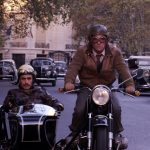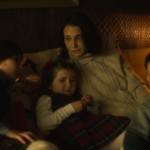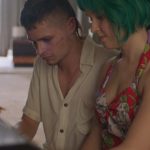Joyce Glasser reviews The Club (March 25, 2016)
Chilean Director Pablo Larraín was born three years after the military coup that ushered in Augusto Pinochet’s 16-year, brutal dictatorship. His films, No!, Post Mortem and Tony Manero are steeped in political context and feature characters who act – frequently heinously – with impunity. Post Mortem takes place during the military coup that ushered in Pinochet’s reign of terror; Tony Manero is set four years into his dictatorship; and No!, Larraín’s most overtly political film, is set during the political campaign that ended it. All three films star sullen-faced, now 53-year-old Alfredo Castro who joins a strong ensemble cast in The Club.
 In The Club, Larraín leaves the repression, lies and cover-ups of the State under Pinochet in the background. In the foreground is the equally political and repressive sphere of the Catholic Church. If The Club was passed over by the American Film Academy as a nominee for this year’s Best Foreign Language Film, it is, by an ironic coincidence, a powerful companion piece to the double Academy Award winning film, Spotlight in which Boston Globe journalists discover that hundreds of paedophile priests were despatched to ‘retirement’ homes around the world, escaping from justice with impunity.
In The Club, Larraín leaves the repression, lies and cover-ups of the State under Pinochet in the background. In the foreground is the equally political and repressive sphere of the Catholic Church. If The Club was passed over by the American Film Academy as a nominee for this year’s Best Foreign Language Film, it is, by an ironic coincidence, a powerful companion piece to the double Academy Award winning film, Spotlight in which Boston Globe journalists discover that hundreds of paedophile priests were despatched to ‘retirement’ homes around the world, escaping from justice with impunity.
In his spine-chilling tale, Larraín takes us inside one such retirement home in the seaside town of La Boca, which means ‘the mouth’ in Spanish and indication of the importance words take on in this astutely scripted film. In a prologue to the main story, we get a sense of the daily routine of the inhabitants of the house. There are silent, scenic shots of the beach set to the music of Arvo Pärt, with perhaps the key references being his music’s use in a Russian film entitled The Banishment and the American film, There Will Be Blood. The references are apt for The Club is about banishment and the deferred consequences (or blood to pay) of past crimes.
We soon meet the four priests and their fastidious caretaker, the ‘retired’ Sister Monica (Antonia Zegers, Larraín’s wife). They have been banished by their congregations and society and share a slightly remote cliff top house. The former priests are Father Vidal (Castro); Father Ortega (Alejandro Goic), a former army chaplain; the rebellious Father Silva (Jaime Vadell); and Father Ramirez (Alejandro Sieveking) who is now senile. They share a restricted, but comfortable routine, which consists of three solid meals a day, strolls on the beach, two prayers sessions and a well-stocked wine cellar that guarantees a sound sleep. The routine, and their finances, are enhanced by Father Vidal’s forays into dog racing, a local pastime.
Then three unwanted guests appear to upset their routine. The five inhabitants of the house are forced to confront feelings that they have buried under layers of self deception so complex, that even the audience has trouble discerning the truth. The arrival of Father Lazcano (Jose Soza), another defrocked priest, causes immediate concern because he is more local, which means, easier for his victims to trace.
And sure enough, the fears of the regular inhabitants are realised when a mentally unhinged fisherman, Sandokan (Roberto Farias), recognises Lazcano. The doorstep of the house becomes his Hyde Park Corner and Lazcano realises he must leave the protection of the house or the man will continue to rave and attract attention.
An unnatural death at the footsteps of the house is the last thing the inhabitants want, and they agree on a cover-up scenario. But the priests and the crafty Sister Monica meet their match in Padre Garcia (Marcelo Alonso), a well-heeled, ‘Spiritual Healer’. He has been despatched by central command to carry out damage limitation and, if necessary, close down the retreat. As the Church closes rank to hide the truth, Padre Garcia devises a devastating, but ironically just solution.
The cinematography by Larraín’s regular DOP, Sergio Armstrong, is fittingly dark and grainy, as though the entire film were shot under the strong mist of the sea, making it difficult, literally, to see clearly. This might annoy some viewers, but form and content merge poetically in the final cover-up sequence and in Padre Garcia’s riveting interviews with each of the priests.
Larraín’s script, co-written with Guillermo Calderon and Daniel Villalobos, is a tour de force, sustained by the strong deliveries of the excellent cast. We listen, for example, to the various testimonies uncertain as to whether they are the honest musings of downtrodden victims of a repressive regime; master classes in self-deception or the devious, knowing lies of serial perverts.
Was Sister Monica really falsely accused of stealing a child whom she was protecting and was she sold down the river by a spiteful, abusive mother? Father Vidal delivers an electrifying sermon to Padre Garcia. ‘I arrived here four centuries ago’ he begins in an almost hypnotic trance. ‘At that time people said that the devil created us. Now people say that God created us to love our neighbour because he is dirty. To love he who has dirty sex; he who laughs at himself; he who is humiliated; he who smokes in the bathroom; he who has to take idiotic questions from people like you…But make no mistake…I know something more than you because in that deep and retched sex I’ve seen the Lord’s most loving light.’
The Club makes demands on its viewers and is not an easy film to watch. It is dark, brutal, and claustrophobic. It is also a powerful cinematic experience commensurate with fellow Chilean Writer/Director Patricio Guzman’s documentary The Pearl Button, released last week.




